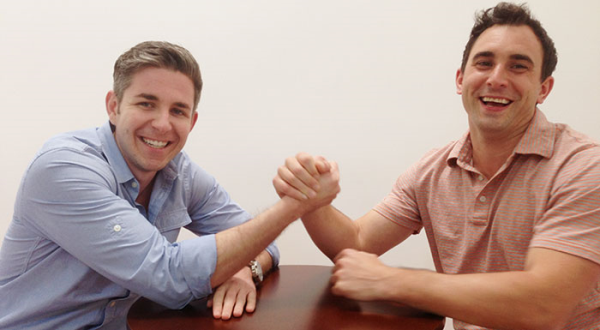Being at a digital innovation company not only provides the opportunity to imagine new products, but also allows you to reimagine established ways of doing things. At BeyondCurious, we actively look for opportunity areas where we can drive extraordinary results.
We recently conducted an experiment to develop ways to accelerate our product development lifecycle. Just like a client engagement, we formed a project team, defined clear objectives, established rules of engagement and set measures of success. We even gave it a name: JumpShot.
In a previous post, I explained JumpShot's rules of engagement, and interviewed one of the project's investors. For this week's post, I interviewed team members Max Goldman and Colin Magee , pictured below, to hear about what they learned from the experiment.

Max Goldman and Colin Magee, Team JumpShot
What was JumpShot?
CM: JumpShot was an internal project with the mission of identifying a market opportunity and developing a marketable product in eight weeks or less. The goal of JumpShot was to accelerate our product development capabilities through experience learning.
What were your roles? How did you divide up work and responsibilities?
CM: I played the role of defining our products vision and roadmap. Max focused on the market segmentation, competitive landscape, etc. We gravitated toward these roles because of our strengths (Max with marketing services, Colin with software development) and the complementary nature of our skills.
What did you hope you would learn on the project?
CM: As a company, we aimed to learn about the mindset differences that a product development company needs to have. My goal was to learn about how the software stack for a product would differ from that of a services product.
MG: My goal was to lead an entire product lifecycle, identify ways to persuade others to help in our efforts, learn how to develop a healthy partnership, and understand how to manage and get investor buy-in.
What did you hope to accomplish?
MG: I hoped to exceed the expectations of my investors by creating a strong argument for our product and its potential opportunity. I also hoped to develop a deeper expertise and sense of comfort with leading the development of an SAAS product.
How did you approach the project?
MG: First and foremost we had to fully understand the current state of the relevant market and how our business goals would potentially fit in. In other words, we went broad before we dove deep. We wanted to present our investors with a streamlined view of what we saw as the opportunity, and leverage their expertise as part of the decision making process. By scoring the various avenues we could potentially pursue, we were able to hone in on a product focus.
How did it feel being in the position of having to win over investors? What did you learn from being on that side of the fence?
MG: I realized that communication is key to leveraging your investors as much as you can, and to having a clear understanding of what they are looking for out of the relationship. Listen and give consideration to everything they say, and don't forget that they are interested in your success. Treat your investors with respect, but don't be scared to challenge them and provide your own unique perspectives.
Did you end up building a product?
CM: No. One of the biggest successes of the project was actually deciding NOT to build the product when the landscape changed and the market wasn't there. That was a tough decision to make, but it was the right decision.
What were the successes of the project?
MG: One huge success was proving that we could complete the assessment and vision for the product, as well as securing internal buy-in in only two weeks, despite both of us being nearly 100% allocated to other projects.
If you had to do it again would you change anything?
CM: I would have kept the product simpler from inception. We went through two rounds of proposals and our first product was too ambitious for the eight week window.
MG: I would qualify the opportunity that was presented. I would challenge the investors' understanding from the get go, and not take anything at face value. Never make assumptions unless you absolutely have to - don't leave anything up to interpretation.
What were your personal lessons learned?
CM: I need to be more open to feedback. I was remote for both of the presentations to investors and it was difficult to defend the ideas over the phone. I got too personally attached to the product idea and ended up being defensive on feedback when it wasn't the right fit for us.
Any advice for people who want to build a product?
1. Know your end goal. You need to know exactly what you are trying to accomplish. If you don't know where you're going, you're never going to get there.
2. Know your investor. Understand your investor's motivations. Make sure if there are multiple investors that they are in alignment and see the opportunity the same way. Make sure you understand your investors' success metric.
3. Know yourself. By honestly evaluating each team member's strengths and weaknesses, you can effectively leverage your collective strengths and build the confidence to act as one.
4. Failure is good if you learn from it. You can learn an incredible amount from failure, as long as you don't let it get you down. Enter optimistic, stay optimistic regardless.
You can follow BeyondCurious on twitter @beyond_curious, or on Facebook.
